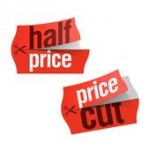If you had to pick 1 thing – 1 strategy or change that you could implement in your business that would allow you thrive despite tough economic times, what would it be?
Let’s make a list of the top 5 things that I hear most business owners (like you) say when I ask them the same question…
- Spend money on marketing – attract new customers
- Have a sale
- Ask for referrals or help
- Tighten your belt – cut costs
- Do more networking
Now what do all of these have in common?
They all involve you doing more of the same thing that you have always done. None of these involve a radical shift in the way that you do business, do they? None of these involve you taking a step back and re-examining what you do and whether it’s actually working. And none of these involve you changing the way that you communicate what you do to your customers.
And that is precisely why none of them will work to recession proof your business.
So why is that important?
Because consumer sentiment and spending has changed dramatically in the past few years and those changes are being felt across every industry and by both big and small businesses. Everything you thought you knew about your customer and why she was buying from you has probably changed. And if you don’t take the time now to re-discover your prospect’s main source of pain – the reason why she needs your product or service – you risk losing more sales and more ground to your competition.
Now some of you are probably sitting there thinking “but MY industry is different. You may think that you’ve been hit especially hard and that everyone in your niche has lost sales. But that’s not the case for 99% of you. Even some of the most competitive and vulnerable industries have companies who have continued to perform well and who have even stole market share.
Just for a moment, I want you to cast your mind back to the first few months after the GFC. A lot of people lost their life savings during the stock market crash and many lost their jobs immediately after that. It was a horrific few months and few industries felt the wrath of the crash more so than the automotive sector. If you remember, new car sales dropped by almost 20% in a short period of time and stayed that way for almost a year. That’s a huge drop in an industry that is vital to the health of the national economy.
Now sales of new cars were down 20% for the industry. Despite the massive drop in sales, 1 manufacturer actually managed to gain market share and outperform all other companies in sales growth. Do you remember who that was and why?
Only 1 company stopped and took a good hard look at the pain their customers were in at the time. They didn’t do what all the others did – which was spend more money on newspaper ads, lay off salespeople and slash new car prices.
Only 1 company examined the change in the market, correctly diagnosed the pain of their prospects and came up with a solution. “If you lose your job and can’t make the payments, no problem – we will take it back free of charge”.
Do you remember who that was? That’s right Hyundai.
With one simple change to their focus and strategy they stole market share from every other manufacturer because they correctly identified the shift in their customer’s pain. They didn’t keep going on with the same old strategy and approach that clearly wasn’t working. Yes, there had been a major downturn and the whole industry was hit hard, but there were still lots of customers who wanted to buy a new car but were afraid to do so because they might lose their jobs.
So how can you apply this to your market right now? First and foremost, your customers are not thinking about you, your brand and your features and benefits – they are thinking about their own survival and whether or not you can cure their pain. If you are able to correctly diagnose the pain, you will trigger the part of their brain that makes decisions and you will stand apart from your competition. That’s the power of Sales Seduction.
Think about one of your customers right now and her pain? What do you need to do in order to get more clarity around that? What questions do you need to ask her about how it is affecting her financially, personally and strategically? To the extent you can diagnose her pain, get her to acknowledge it and put forward the solution that cures it, she will listen to anything that you have to say.
Take a look around you… businesses are closing their doors everyday – which means more potential customers for the businesses like you that DO survive. And in times like these, it’s going to take more than just doing more of what you have always done to recession proof your business. Uncertain times call for deliberate decisions and proven practices. In order to recession proof your business you need to shift your thinking around the way you do business and start providing THE solution to the #1 pain or challenge that your customers have. And if you need some diagnoistic questions and a step-by-step framework to help you do this…I highly recommend that you check out Chapter 8 of Sales Seduction.
 I have read quite a few articles and blogs lately from business coaches who advocate that you should spend money to get “likes” on your business page in Facebook and followers on other forms of social media. With all due respect, this is by far the most foolish and financially irresponsible strategy I’ve ever heard of. If your coach or advisor is telling you to do this, you need to need to understand that there are at least 3 good reasons why you should NEVER do this:
I have read quite a few articles and blogs lately from business coaches who advocate that you should spend money to get “likes” on your business page in Facebook and followers on other forms of social media. With all due respect, this is by far the most foolish and financially irresponsible strategy I’ve ever heard of. If your coach or advisor is telling you to do this, you need to need to understand that there are at least 3 good reasons why you should NEVER do this:
- While it is nice to have people like your page, you need to think about what the end game is. Likes don’t put money in your bank account and food on the table for your family. What you really need in your business is a good steady stream of qualified leads who are ready to pay you for your solution. Likes are not leads. They may like your page one day and never return or pay very little attention to the posts on your Facebook page.
- Facebook has recently changed the way their ads work (yet again) for posts on your business page. Even if you have thousands of followers, you must now pay to talk to them. In the old days, you could send messages and your posts were given priority in the newsfeed of your followers. Not anymore. Now, you must pay to promote each post you make or virtually no one will ever see it (no matter how many likes you have). With Facebook, you must pay to acquire the likes AND also pay to speak with them.
- When you send traffic to your own website and they give you permission to contact them, you are building the most important asset in your business: your list. Your list allows you to build a relationship with prospects and customers and it also buys you time to present your claim, solve their pain and prove that you can do it. Once you own your list, speaking to them is virtually free. No matter what, you have this list and it is always the most cost effective way of building your business. If someone else, like Facebook or any other social media site, owns your list, then they control how, what and when you can communicate – and how much you must pay to do it. If Facebook went off line or out of business, what would happen to the so-called list of followers you paid dearly to acquire?
As a small business can you really afford to buy likes on social media or should you spend your time and limited marketing budget on generating qualified leads who will pay you for your solution?
The most successful brands in the world don’t waste their money on likes. Instead they focus their time and money on influencing and persuading you to buy their solution. They know exactly how to push the “buy button” in your brain and they do it successfully over and over again.
They have ALL mastered 1 simple technique and they secretly hope that YOU will never discover what it is. As a small business owner, they currently have an unfair advantage over you but that is about to change… In my free online event on December 6th, 2012, I will reveal why this 1 technique is so damn effective and how you can use it to instantly influence and persuade your customers.
14 Nov 2012
Can I Get a Discount?
Which question from your prospects and customers scares you the most?
If you are like most business owners we work with, you will probably answer:
- How much does it cost?
- Can I get a discount?
- Why should I choose you and not your competitor? or
- Can you provide a guarantee?
While all of these are intimidating and sometimes difficult to overcome, they all have one positive thing in common – your prospect is giving you a signal that she is interested in buying from you but she needs for you to help her overcome her objection. She has already started to think about trying your product/service but she is unsure about at least one aspect.
And for that reason – you can take those questions as a sign that a sale is in fact still possible.
However, the question that should frighten you more than any other because it is by far the worst one that you get from your audience is – Can I have some time to think about it?
Thinking is counter-productive to deciding. Whenever you put your prospect into a position where they have gone into the thinking part of their brain, you will not get a decision. Thinking takes place in one part of your brain (the neo-cortex), while deciding happens much more quickly (and automatically) in your old or “reptilian” brain.
Let’s examine where you went wrong…
The biggest part of your brain is the neo cortex. It is the last thing that forms in the womb and it lights up when we listen to music, look at colours, speak, read and process numbers. If you ever hear people talking about right vs. left brain thinking, they are talking about the neo cortex. In a nutshell – this part of your brain THINKS.
So when your customer says “I need to think about it” this part of the brain is firing up and looking for data. Neuromarketing research has revealed that this uses up tons of her brain energy and prolongs the decision making process. So, if you want to drag out the process of getting your customer to decide or compete on price, you want to make sure that your customer has to us this part of her brain. Make sure you give your customer lots of BIG words, numbers, graphs, lists of features and benefits, talk about your competitors and how you stack up next to them – and your customer will NOT decide <that is guaranteed> buts he will do a whole lot of thinking and take up more of your valuable time and energy in the process.
If you want to get your customer to decide, you must tailor and deliver your message to her old (reptilian brain). It lights up even before she has conscious awareness that she has made a decision. Now, while it is very true that this is the most primitive part of her brain, the good news is that it is very predictable. By understanding how this part of the brain works, you will never again bore and overwhelm your customers AND you will never again be lured into the trap of having your audience tell you that they need to think about it.
How will you do this? By understanding how this part of your customer’s brain works, you can help her to use the least amount of mental energy in processing your message which means that she will make quicker decisions. It is important to remember that unlike the neo-cortex (the thinking part of her brain), this part right of her brain is automatic – it does not think, it only DECIDES and ACTS. It is always at work scanning her environment looking for information of value to her survival. In order to avoid having your customers ask for time out to think about whether they need your product/service, you need to grab their attention up front quickly, deliver your strongest claim first and show her how your solution is going to solve her primary source of pain. This is the essence of Step 1 in the Sales Seduction process.
 I got a 15 page sales letter the other day from a marketing coach trying to convince me to attend his seminar. It was the perfect example of what NOT to do. If you want to attract more clients and make it easier for them to say “Yes” to working with you, you will want to pay particular attention to what I am about to share with you right now.
I got a 15 page sales letter the other day from a marketing coach trying to convince me to attend his seminar. It was the perfect example of what NOT to do. If you want to attract more clients and make it easier for them to say “Yes” to working with you, you will want to pay particular attention to what I am about to share with you right now.
You may not know this but there are reportedly over 14,000 sales and marketing books on Amazon – and most of them (like the email from this coach) deal with techniques and strategies that cause your prospects to waste valuable time and energy thinking. Without realizing it, these techniques cause your audience to have to use their neo cortex (the thinking part of their brain) to process what you are saying.
While some of these techniques may work for some of the people some of the time, they are not reliable or predictable because they are designed to trigger the wrong part (the thinking part) of your prospect’s brain.
So, what do top sales and marketing coaches do to help their audience to decide quickly?
Clearly there are some principles that work – there is a process to marketing and selling products and services effectively. However, some of these principles (while valuable) have been taken to the extreme by many experts and coaches. In doing so, they dilute your message and make it ineffective. Without realizing it, these strategies will kill your ability to close sales because they will make it difficult for your audience to decide anything.
For example, I’m sure you have heard of the concept of “social proof”. This was first proposed by Dr. Robert Cialdini and it essentially means that before people decide, they will often look to what other people do before making their decision. It explains why customers will choose to go to a restaurant that is full and has a line up outside ,when the one next door is almost empty and there are plenty of tables available.
According to Cialdini, you will assume that the busy restaurant must be better because others have decided to eat there. Social proof is an important driver and on some level, it does help your brain to make decisions more quickly. Your customer wants to find a solution to her pain but she is also afraid of taking a risk. Social proof is one factor that can help to swing the balance in favour of your product or service.
However, too often this principle is taken to the extreme. Take my example of the marketing coach who sent me a ridiculously long sales letter. 5 out of 15 pages were designed to show you how many people have used and love his products. Does this seem like a bit much to you? Is it possible that his long winded letter (while paved with good intentions to provide social proof), might have had the undesired effect of causing the audience to engage the thinking part of their brains… and ask for more time to “think about it”?
Social proof is a great tool in your marketing belt but it is not as effective as understanding the 7 Stimuli that trigger the decision making part of your customer’s brain. Knowing these 7 simple and effective triggers, can transform how you talk to your customers and the results you achieve. And the 7 Stimuli which trigger the part of the brain that decides, are part of my simple, step-by-step process called Sales Seduction. Sales Seduction, is based on neuromarketing principles, and it can help you go from confusing your prospects, to convincing them.
02 Oct 2012
Can You Offer it at a Cheaper Price?
Do Your Prospects Often Ask You For a Cheaper Price?
What would it be worth to you if you could STOP competing based on price?
Knowing this valuable information before you craft your next sales or marketing message, can help you to influence your customer to decide quickly and make price a non-issue.
If your sales process is currently taking too long, this information will help you close sales faster.
If your customers need to “think about” doing business with you, this information will help you to stop boring and confusing them.
If your customers keep asking you for a better price, I am going to show you how to get the price that you deserve.
We now know there are 3 distinct parts of the brain and each one of them has a different function. However, only 1 of them is responsible for decision making and it fires up around 8 seconds before you are consciously aware that you have even made a decision. The research and information I am about to share with you hasn’t come from psychology, the personal development industry or even a marketing agency – these findings were made by neuro scientists, medical doctors studying brain wave activity with FMRI machines. They were looking to find out which part of your brain lights up when it is presented with different stimuli and the findings have been documented and published in respected publications like the Wall Street Journal and the Harvard Medical Journal.
The biggest part of brain is the neo cortex. We are the only species on the planet that has developed this part of the brain. It is the last thing that forms in the womb and it lights up when we listen to music, look at colours, speak, read and process numbers. If you ever hear people talking about right vs. left brain thinking, they are talking about the neo cortex. In a nutshell – IT THINKS.
Similarly, when your customer says “I need to think about it” or “is this the best price I can get?” this part of the brain is firing up and looking for data. This uses up tons of your brain energy and prolongs the decision making process. So, if you want to drag out the process of getting your customer to decide or compete on price, you want to make sure that your customer has to us this part of his brain. Make sure you give your customer lots of BIG words, numbers, graphs, lists of features and benefits, talk about your competitors and how you stack up next to them – and your customer will NOT decide <that is guaranteed> but he will do a whole lot of thinking and take up more of your valuable time and energy in the process.
Let’s move on to the middle or mammalian brain – this right here is the part of the brain that we share will every warm blooded creature on the planet. This is where you process emotions and feel. But this is not where you make decisions.
At the top of your spinal cord, there is a collection of neurons – which are commonly referred to as the old or reptilian brain. This is the first part of your brain that is formed in the womb and it is the part that keeps you alive – all bodily functions that take place below the level of consciousness, are controlled by this part of your brain.
It is your fight or flight brain – and its sole responsibility is to ensure your survival. It houses the amgydala – which is the chemical factory in your brain that regulates all bodily functions. And it is the part of the brain that lights up when you DECIDE.
It lights up even before you have conscious awareness that you have made a decision. Now, while it is very true that this is the most primitive part of your brain, the good news is that it is very predictable. By understanding how this part of your brain works, you will never again bore and overwhelm your customers AND you will never again be lured into the trap of competing based on price.
How will you do this? By understanding how this part of your customer’s brain works, you can help him to use the least amount of mental energy in processing your message which means that he will make quicker decisions. It is important to remember that unlike the neo-cortex up here (the thinking part of your brain), this part right of your brain is automatic – it does not think, it only DECIDES and ACTS. It is always at work scanning your environment looking for information of value to your survival.
So you might be wondering how does this apply to the price that you charge for your product or service? Just for a moment, I want you to imagine that you are in the business of selling pizzas. Now, it doesn’t matter whether your business is called Pizza Hut, Dominos, Eagleboys, Boston Pizza or Pizza World… you are basically selling an undifferentiated product and the market that you find yourself in looks price conscious, doesn’t it? The reason for that is simple – the consumer finds it hard to distinguish between your pizza and the next guy.
Now if you happen to BE the owners of a Chicago Deep dish pizza shop you might argue that your pizza is better because your crust is thicker and you provide more toppings and value. But in the eyes of the consumer, your pizza is still not really worth much more than the next guy’s pizza. You might be charging $20 and your competitor is charging $18.50. Why is that?
It’s because even though you think there is a difference, in the eyes of your customer, there isn’t. 95% of what you and the next guy offer are essentially the exact same thing. And as long as you keep operating in that zone with a marketing message that doesn’t stand out and stake a claim, you will continue to compete on prize because your customer is up in his neo-cortex trying to figure out which pizza is the best one to order.
So knowing this, what could you do differently? Well one company in 1973 identified a way to stand out and grab market share. It didn’t claim to have the best, the thickest or even the cheapest pizza, it just made you a promise that if you ordered from them, you would get it in 30 minutes or your pizza was free. It was the most successful campaign in the history of the industry – for good reason.
Think about it, when you order a pizza, what is the one question that you have in the back of your mind? I wonder when the pizza will get here?
Dominos answered that question for you. They stopped making you need to think about it and they triggered the part of your brain that decides and dials.
This is the power of Sales Seduction – understanding why your customer says YES and helping him to say YES to your product/service. Can you see now how knowing this information can help you accelerate your sales process, close more business, trigger decisions and allow you to charge a fair price for your product/service?
Great – so your homework today is to go back through one of your sales or marketing messages and identify all the ways that you are boring or overwhelming your prospects. The key to NOT competing on price ever again, is in making it easier for your customers to say ‘YES’.
















